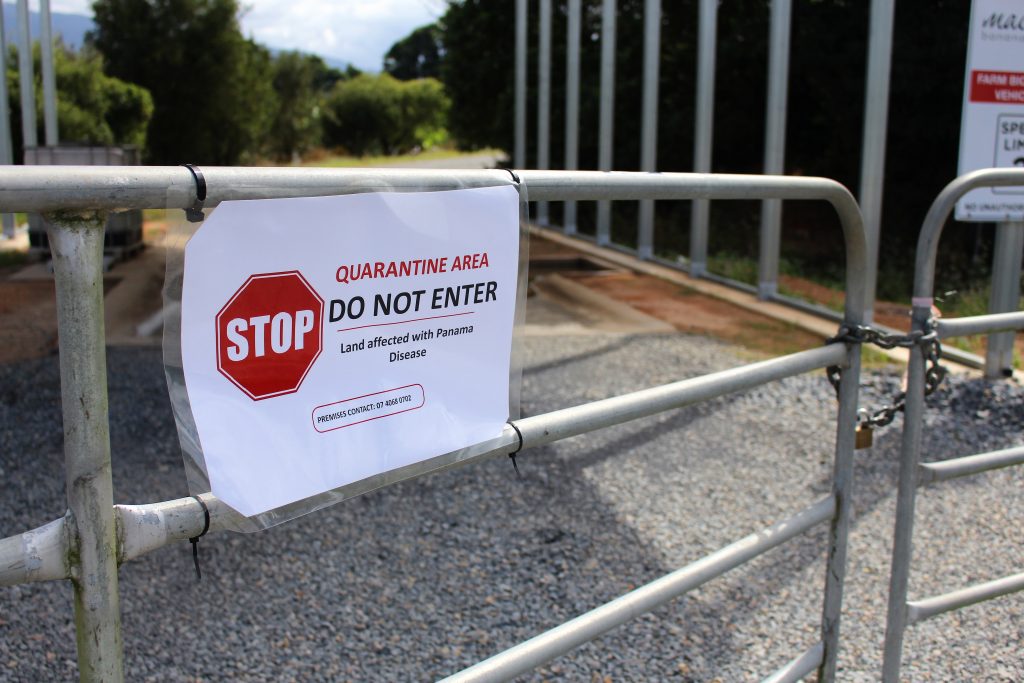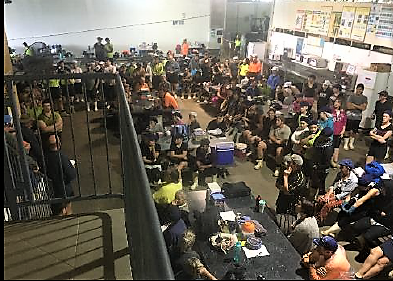Since the initial detection of TR4 in the Tully Valley in 2015, Australian Banana Growers’ Council (ABGC) and Biosecurity Queensland (BQ) have attempted to keep Queensland banana growers abreast of biosecurity best practices designed to offer the greatest protection against potential spread of the disease.
However, with the number of confirmed TR4 cases growing to three in two years, some valuable learnings on farming with Panama have also been gained.
Many of these have come from the growers themselves that have been directly affected by the disease.
By Sonia Campbell
With three properties in the Tully Valley now confirmed with Panama TR4, the aim of ABGC and Biosecurity Queensland is to continue to help most at-risk growers ready themselves for their own potential TR4 infection.
Offering valuable insight into this effort have been the owners of the two banana farming properties who continue to operate with the disease.
Their learnings are not only helping other growers to better prepare their businesses for a possible TR4 detection, but are offering greater potential protection to industry at large.
LESSONS LEARNT
In July 2017, the MacKay Farming Group’s Bolinda Estate became the second Queensland property to record a positive detection to Panama Tropical Race 4 (TR4).
However, the stringent biosecurity protocols implemented by the company well before the incursion, meant the packing shed on the affected property stopped for just two hours after the initial quarantine notice was issued.
Gavin Mackay, who manages Bolinda Estate with cousin Stephen, said the brief production downtime was not only testament to how effective strict on-farm biosecurity practices can be, but having these measures in place well prior to a detection, was crucial to the farm’s ability to continue to trade.
“There is no doubt having those measures in place and consulting with BQ makes the transition easier,” Gavin said.
“If we didn’t have the systems in place that we did then we would have been looking at a much greater downtime and we wouldn’t have been able to continue to get back to farming as quickly as we did.’’
Stephen agreed: “It was definitely our saving grace, having a good system already in place made things so much easier, and meant our staff were ready to respond.”
SIMPLE CHANGES CAN MAKE BIG DIFFERENCE
There is no question that the Mackay’s have one of the most sophisticated on-farm biosecurity management plans known to industry. It includes a colour-coded zonal system—with different coloured gumboots for each farm zone—sanitation dips for vehicles, footpaths, wash down facilities, perimeter fencing and more.
However, Gavin and Stephen say growers should not be daunted by the task of improving their biosecurity management plans.
They say even basic changes can make a real difference to protecting your asset and getting back to business, in the event of a detection of TR4.
“Even simple things like creating a biosecurity aware culture within your staff, whereby you communicate regularly through toolbox talks, to provide work instructions or deliver general biosecurity information,” Gavin said.
“This way if you do become infected staff are accustomed to getting instructions delivered in a timely and systematic fashion. And it will be easier to make them aware of TR4 and the new procedures they will be required to carry out in order to satisfy the quarantine notice and continue to trade.”
CHANGE OF THINKING
One of the biggest on-farm challenges a grower can face after a positive TR4 detection is changing their focus from keeping the disease out, to keeping it in.
“The main thing we had to do was change our thinking from the farm being ‘clean’ to now ‘dirty’,” Gavin explains.
“Almost immediately the infected area was fenced and all plants in the zone were treated as per BQ instruction.
“To reduce all movement of people and machinery we isolated a 40 acre area around the destruction zone, destroying all plants in the area, with the plan never to re-enter that area again as our best chance of containment.”
CLEAN ACCESS ROADS
In order to return to production (and meet BQ requirements) the Mackay’s installed clean access roads—using geofabric and gravel—to packing sheds and clean access points, in order to move bunches and stay in ‘clean’ zones.
Growers with multiple parcels of land, and/or packing sheds that are located separate to production areas, would also need to consider how they would move their fruit across non-contiguous zones.
SIGNAGE/ZONING
Well-placed signage, including painting instructions onto concrete walkways, can ensure visitors and staff know what zone they are in and what footwear they should be wearing at all times.
“Painting instructions on the ground can be a very effective method of getting key messages across to both staff and visitors, particularly when it comes to letting people know where they can and cannot walk,” Stephen explains.
“Different parcels of land will need completely different boots and tools, so colour-coding these boots and tools—even with ear tags—will allow them to be easily identified and prevent mix ups,” he said.
INVEST NOW—SAVE LATER
When it comes to preparing for a possible TR4 infection, both Gavin and Stephen have the same philosophy—“If you’re going to do it, do it now”.
“Once a farm has been issued a notice from BQ, any biosecurity upgrades or farm system changes are much harder and far more costly to carry out.”
“Even getting a contractor in to put up fencing once you’ve been confirmed with TR4 will not only be far more challenging, it will also be considerably more costly.
Likewise, moving farm machinery, vehicles and other farm appliances will require a great deal more heartache once your farm is locked in a quarantine zone.
ACKNOWLEDGEMENT
The ABGC would like to thank the Mackay family—including Gavin, Stephen, Barrie, Cameron and Daniel Mackay—for their generosity and consistent willingness to share their knowledge with the wider banana industry, particularly fellow growers in the Tully Valley.
Their contribution to industry goes well beyond their own farm gates and has allowed the ABGC and BQ to provide valuable feedback to other growers in high-risk TR4 zones, on how to continue to operate a working business on an infested farm.
Special mention must also go to Naomi Abbott, of Mackay’s Banana Marketing, who has also played an integral role in sharing her valuable knowledge on biosecurity best practice protocols, with ABGC and industry at large.
And thank-you also to Warwick Flegler for generously offering his feedback and learnings, which has also greatly assisted the ABGC and BQ.




